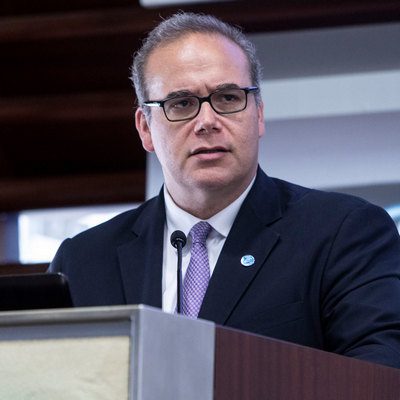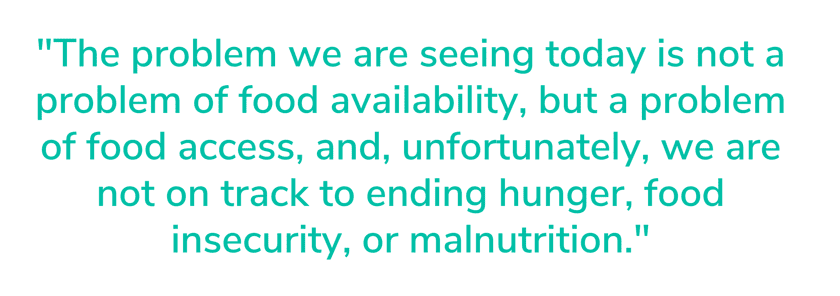By Katie Lutz
According to the United Nations, we’re moving into a cost-of-living crisis unlike anything seen in a generation. One large component of that crisis is skyrocketing food prices. In March, the Food and Agriculture Organization’s (FAO) Food Price Index hit a record high, retreating only slightly in April and May. However, world food prices remained very high relative to historical levels. Experts predict that food prices won’t decrease significantly anytime soon, especially if energy prices remain elevated.
Recently, we sat down with Dr. Máximo Torero, Chief Economist of the FAO, to discuss the access issues of cereal crops, the importance of fertilizer for global food security, and how we can avoid a global hunger crisis.

GFN: How are rising food prices affecting global agri-food systems and food security?
Dr. Máximo Torero: Before the war in Ukraine, we already had a problem with food prices rising since mid-2020, with 193 million people in 53 countries or territories in an acute food security crisis. The reasons behind the aggravating food security situation are conflicts, the adverse impact of climate, and the economic slowdown due to the COVID-19 pandemic. Another important driver is the high cost of healthy diets, which has put nutritious food out of reach for about three billion people worldwide. The situation has been exacerbated by the war in Ukraine with a huge impact on the affordability of food, not only of the minimum calorie requirement but also of healthy diets. There is enough food globally, but we have a problem of accessibility.
The situation in 2022 could deteriorate further compared to 2021 due to the combined effects of multiple overlapping and mutually reinforcing factors, including organized violence and conflict, economic shocks, and weather extremes. The rising prices of energy and inputs, namely fertilizers, are adding to the problem.
Again, I wish to reiterate that the problem we are seeing today is not a problem of food availability, but a problem of food access, and, unfortunately, we are not on track to ending hunger, food insecurity, or malnutrition.

What is the distinction between food availability and food access?
Availability is about having enough food in quantity terms, while access is about having the economic means to buy the needed food for a healthy life.
Right now, we are experiencing a lack of access to food because food prices are very high compared to incomes, particularly in low- and lower-middle-income countries. In the case of wheat, for example, there is enough produce for everyone even if Ukrainian supplies are still being blocked in the country. Food import bills are at record levels, and what we observe is that countries are spending more money for less food. The global food import bill in 2022 is estimated to rise by US$ 51 billion to $1.8 trillion, with $49 billion due to higher import costs rather than volumes. Of course, this could have serious food security problems, especially for poor households that spend a large share of their incomes on food.
However, in the next season we could move from a problem of lack of access to food to a problem of lack of food, which would be disastrous.
What else could cause that shift?
While access to cereal crops is extremely important, as basic foods, we must remember that availability is not equally distributed around the world. What could cause the shift from a food access crisis to a food availability crisis is the rising cost of inputs, in particular fertilizer. For instance, lack of availability and high prices of fertilizers would mean less application, and thus lower yields and production globally, which would exert an additional upward pressure on food prices and aggravate food insecurity. If we ensure that fertilizer is available and affordable, that will also help in addressing the problem of the soaring food prices.
How long do we have to act before we have a food availability problem?
The window of opportunity is closing. I believe we have a couple of months, maximum, to act on fertilizer and procure what is needed for farmers to grow crops in the next season. We must not forget that we could lose a good portion of the 30 percent of the world’s wheat exports coming out of Ukraine and Russia. If this loss in exportable availabilities is not compensated by other countries, this will no doubt result in even higher food prices.
It is my belief that we must resolve these issues in the next two to three months to avoid a hunger crisis and social unrest next year.
What other potential implications of a food crisis?
If we were to see a food crisis in the next several years, we would also likely encounter a sustainability crisis. We need to ensure that we minimize the tradeoffs between protecting global food security and protecting natural resources. It is quite possible that, in trying to ensure food security, we could put our biodiversity and environment at risk. It is important that we follow a twin-track approach by addressing the immediate problem while also working on longer-term objectives. The current problem should not divert our efforts aiming at achieving more efficient, inclusive, resilient, and sustainable food systems.
We must also rethink our policies in terms of food waste, much like the work your team is doing with the Harvard Law School Food Law and Policy Clinic, through the Global Food Donation Atlas. We will have to create incentives that promote the reduction of food loss and waste and target food and social safety systems. I see food banks playing a key role as part of the solution.

Can you elaborate further on the role of food banks in mitigating or responding to a hunger crisis?
Food banks played a crucial role during COVID-19; they proved that by increasing access to food, they could help minimize the risk of a global hunger crisis. For example, when school feeding programs were not active, food banks stepped in to ensure that children in their communities had consistent access to meals. Food banks can also reduce food losses and help in saving the planet and our natural resources.
It’s clear that food banks have an even greater role to play in creating sustainable food systems. I’d love to explore other ways to accelerate response to avoid a potential global food crisis.
For more context on rising food prices, watch Dr. Torero’s presentation, “What’s in Store for World Food Prices? Is a New Hunger Crisis Inevitable?”